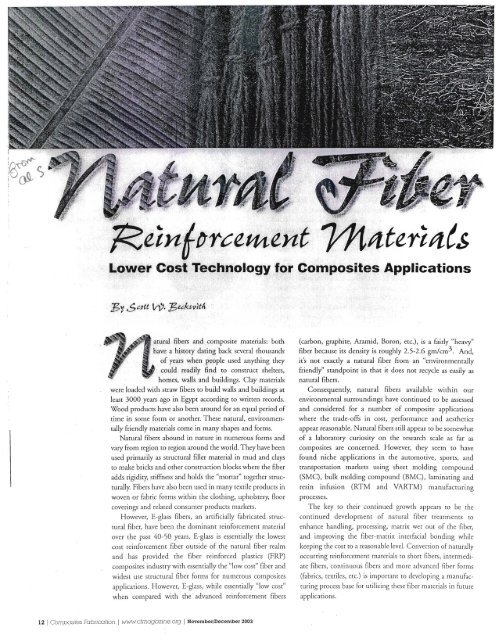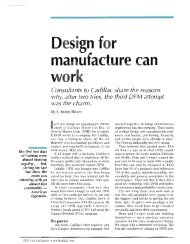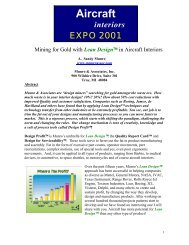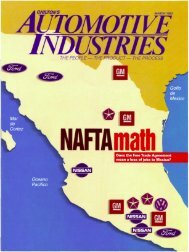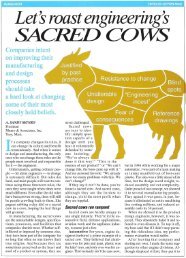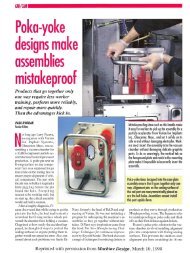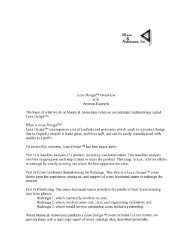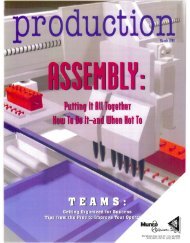Composites Fabrication - Natural Fiber - Sandy Munro
Composites Fabrication - Natural Fiber - Sandy Munro
Composites Fabrication - Natural Fiber - Sandy Munro
You also want an ePaper? Increase the reach of your titles
YUMPU automatically turns print PDFs into web optimized ePapers that Google loves.
ReintbrCetUent 11tJlteriVll.s<br />
Lower Cost. Technology for <strong>Composites</strong> Applications<br />
atura! fibers and composite materials: both<br />
have a history dating back several thousands<br />
of years when people used anything they<br />
could rC4dily find to construct shelters.<br />
homes, walls and buildings. Clay materials<br />
were loaded with straw fibers to build walls and buildings at<br />
least 3000 years ago in Egypt according to written records.<br />
Wood products have also been around for an equal period of<br />
time in some form or another. These natural, environmentally<br />
friendly materials come in many shapes and forms.<br />
<strong>Natural</strong> fibers abound in nature in numerous forms and<br />
vary from region to region around the world. They have been<br />
used primarily as structural filler material in mud and clays<br />
to make bricks and other construction blocks where the fiber<br />
adds rigiclity, stiffness and holds the "mortar" together structurally.<br />
<strong>Fiber</strong>s have also been used in many textile products in<br />
woven or fabric forms within the clothing. upholstery. floor<br />
coverings and related consumer products markers.<br />
However. E-glass fibers, an artificially fabricated structural<br />
fiber. have been the dominant reinforcement material<br />
over the past 40-50 years. E-glass is essentially the lowest<br />
cost reinforcement fiber outside of the narural fiber realm<br />
and has provided the fiber reinforced plastics (FRP)<br />
composites indusrry with essentially the "low cosr" fiber and<br />
widest use structural fiber forms for numerous composites<br />
applications. However, E-glass, while essentially "low cost"<br />
when compared with the advanced reinforcement fibers<br />
(carbon, graphite. Aramid, Boron, erc.). is a fairly "heavy"<br />
fiber because irs densiry is roughly 2.5-2.6 gm/cm 3 . And,<br />
ir's nor exactly a narural fiber from an "environmentally<br />
friendly" srandpoint in rhat it does not recycle as easily as<br />
natural fibers.<br />
Consequently, natural fibers available wirhin our<br />
environmental surroundings have continued to be assessed<br />
and considered for a number of composire applicarions<br />
where rhe rrade-offs in cosr, performance and aesrherics<br />
appear reasonable. <strong>Natural</strong> fibers srill appear ro be somewhar<br />
of a laboratory curiosiry on rhe research scale as far as<br />
composires are concerned. However, rhey seem to have<br />
found niche applications in rhe automorive, sports, and<br />
rransportarion markets using sheer molding compound<br />
(SMC), bulk molding compound (BMC), laminaring and<br />
resin infusion (RTM and VARTM) manufacruring<br />
processes.<br />
The key ro rheir continued growth appears to be the<br />
continued development of narural fiber trearments to<br />
enhance handling, processing. matrix wer our of rhe fiber,<br />
and improving rhe fiber-matrix interfacial bonding while<br />
keeping the cosr to a reasonable level. Conversion of naturally<br />
occurring reinforcemenr materials to short fibers. intermediare<br />
fibers, conrinuous fibers and more advanced fiber forms<br />
(fabrics, rextiles. etc.) is important to developing a manufacturing<br />
process base for utilizing these fiber materials in furure<br />
applicarions.<br />
12 I Composiles FabrIcation I wwwclmagazine.org I November/December 2003
Categories of natural fibers<br />
<strong>Natural</strong> fiber materials are derived from several sources within nature and<br />
the agricultural community. These materials are basically "cellular" in form<br />
and structure with a degree of inherent strength and stiffness built in<br />
"naturally" due to the geometric internal structure. One ofthe basic cellular<br />
materials is cellulose. As a natural polymer itself, it possesses vety high<br />
strength and stiffness per unit weight--exaccly the type of performance<br />
that drives today's advanced composites technologies. Cellulose forms long,<br />
fiber-like cell structures that are found in wood cores and stems, leaf<br />
materials, and seed materials. These are the three dominant sources for<br />
natural fiber materials.<br />
Table 1 shows the three basic categories ofnatural fiber sources aIid their<br />
characteristics. Each of these sources has a spot for their use within the<br />
composites industry. <strong>Natural</strong> fiber resources also provide materials more<br />
commonly used in sandwich construction (core) designs with more well<br />
known materials such as balsa wood, reed, and bamboo forms. For this<br />
article, we will not cover the sandwich structures but will concentrate more<br />
on shon fibei and con"tinuous fiber forms.<br />
Bast <strong>Fiber</strong>: The "bast" fiber family generally consists offlax, hemp, jute,<br />
kenaf, and ramie ("China Grass"). These fibers are derived from wood core<br />
and stem materials. The wood core is basically surrounded by the stem and<br />
the stem consists of a number of fiber bundles. Cellulose is the primary<br />
chemical basis for the fJament structure that makes up the fiber bundles.<br />
The cellulose is the essential filament and is bonded or held together by a<br />
natural "resin" from either the lignin or pectin family. (Note: The intent is<br />
not to get too heavy on "chemistry stuff" here, so we will tread lightly and<br />
just cover things in general.)<br />
During the processing to obtain the natural basttype<br />
fibers, the pectin is removed during the system<br />
that leaves only the filaments and lignin. The fibers<br />
are processed into suitable reinforcement forms that<br />
include short fibers (5-30 mm), continuous fibers or<br />
textile-type fiber forms. In order to fabricate a traditional<br />
composite, the resin system chosen to bond the<br />
fibers within the structure is used to impregnate the<br />
fiber structure using a number ofavailable processing<br />
methods. However, the lignin actually is a weak link<br />
in the critical interface bond region between the<br />
natural fiber and the incoming strucrural resin matrix.<br />
The lignin material between the cells of the fibers,<br />
being the weakest link, is not desirable and every<br />
attempt is made to remove it or treat the fibers chemically<br />
to enhance the resin bond later.<br />
Flax has a fairly high level oflignin. Consequently,<br />
flax fibers are often treated to mitigate the lignin<br />
effects. Boiling in alkali is an approach often used to improve the bond<br />
characteristics of flax composites.<br />
Flax and jute are probably the most commonly used bast-type fibers<br />
today. Jute is the most common because it is fairly inexpensive. It has fairly<br />
good strength but is not as strong or as stiff as flax fibers.<br />
Leaf<strong>Fiber</strong>: Leaf fibers include sisal, abaca (from the banana plant), and<br />
palm materials. These fibers tend to be much coarser than the bast-type<br />
fibers overall. We have probably heard ofsisal more than any of the others<br />
in the group. Sisal is the most important and has a relatively high stiffness<br />
compared to the others.<br />
Seed <strong>Fiber</strong>s: The last group, seed fibers, covers cotton, coir (coconut<br />
husk materials), and kapok materials. Cotton is easily recognized for its<br />
widespread international use in rexriles and other fibrous products within<br />
the clothing and rope industries. Coir obviously is a much more durable,<br />
thick and course fiber material as we probably know just from picking up<br />
a coconut husk. Many of these materials are used for upholstery and<br />
"stuffing" furniture products.<br />
<strong>Natural</strong> fiber propel'ties provide v(uiety<br />
We have already noted that there are basically three fiber categories as shown<br />
in Table 1 and that there are many subclasses within those three categories.<br />
Table 2 shows some of the critical performance properties of these natural<br />
fibers in comparison to conventional E-glass flber. The range of prices<br />
cum:ncly in the marketplace is also shown in relation to E-glass fiber.<br />
The densities of all of the natural fibers lie roughly in the 1.25·1.51<br />
g/cm 3 range. With E-glass fiber sitting at 2.57 g/cm 3 , this means that<br />
.'Jm!ERrnfS,\g~t~2i£~S:i>I~'itL=~~;il9!S:<br />
·i· B~t<strong>Fiber</strong>s' . ;~ Ff~ ...." '. .. . • Fila:m~'n~ ate ttiade fro~cellulose<br />
.(trofIi ,~bQd .. ,~ He~p .. iignin oip~ctinboncl$<br />
, cores/~tepls) - Jute ;. filamentS'toge¥ier<br />
• Kenaf<br />
• Lignin is w~ link in system<br />
• Ramie/China Grass • Jute is mos(common material<br />
• Sisal<br />
• A.~acalB;mana<br />
• P
..<br />
Table 2. Comparison of natural fiber reinforcement materials<br />
with E-glass fibers<br />
NATURAL FIBER REINFORCEMENT MATERIALS<br />
PROPERTIES<br />
E-Glass Flax Jute Hemp Conon Ramie Coir Sisal Abaca<br />
Densily. g/cm 3 257 140 146 148 151 150 125 1.33 150<br />
Tensile Strength. 3450 800-1500 400-800 550-900 400 500 230 600-700 980<br />
MPa (Ksi) (500) (115-215) (60-115) (80-130) (60) (75) (35) (85-100) (140)<br />
Tensile Modulus. 72 60-80 10-30 70 12 44 6 38<br />
GPa (MSI) (105) (87-11.6) (15-44) (10.2) (17) (64) (0.9) (55)<br />
Specific Modulus 28 25-45 7-20 45 8 30 5 30<br />
Elongation ('Yo) 4.8 12-16 1.8 16 3-10 20 15-25 20-30<br />
Moisture Absorption None 7 12 8 8-25 12-17 10 11<br />
(wt 'Yo)<br />
Price ($i1b) 080 0.25-070 0.15 0.25-075 070-100 070-110 0.10-0.20 025-030 070-115<br />
(he natural fibers are 50-60 percent of the E-glass density. This is one of<br />
the major drivers for natural fiber composites on a weight basis alone.<br />
Aramid fibers, traditionally among the lightest weight materials for true<br />
structural composites, is somewhere in the middle of the natural fibers at<br />
roughly 1.42 g/cm 3 .<br />
The other major factor from Table 2 that often favors natural fiber<br />
composites is price per pound (USDllb). It is important to note that the<br />
natural fiber prices cover a fairly wide range. In all cases the natural fiber<br />
prices exhibit a lower price than E-glass, but the prices cover a pretty<br />
broad range. For example, cotton, ramie and a~aca fibers all exhibit a<br />
price that can be above E-glass fiber by a fairly significant amount. Jute,<br />
coir and· sisal appear to consistently<br />
show very low prices and, consequently,<br />
have been explored for use in<br />
composite products more often that<br />
the other materials. Part of (he<br />
problem with the broad price range is<br />
the tie-in back to natural fiber availability<br />
for actual producrion use in<br />
composites in the forms desired by (he<br />
manufacturers and the applicarions.<br />
At the present time, it appears that<br />
natural fiber production for composites<br />
use is nor focused enough to drive<br />
the prices to more stable levels and<br />
product forms.<br />
<strong>Natural</strong> fiber performance properties<br />
are somewhat a mixed bag. The<br />
tensile strength of natural fibers does<br />
not come up to the level of traditional E-glass. With the exception ofcoir<br />
and cotton at roughly 7-12 percent of E-glass strength, the majority are<br />
typically about 15-45 percent of E-glass fiber strength. Consequently the<br />
tensile strength of natural fibers alone is not the driver for their use in<br />
composite components.<br />
Tensile modulus of the natural fibers fare better. While these fibers are<br />
do not surpass E-glass fiber, they do exhibit mnsile moduli that are typically<br />
40-95 percent of the E-glass. However, jute, cotton, and coir exhibit quite<br />
low modulus values. Jute, when processed from certain sources, can<br />
demonstrate modulus values that are at least 45 percent ofE-giass fiber and<br />
are still attracrive for low cost composites. Flax, hemp, ramie and sisal are<br />
14 I <strong>Composites</strong> <strong>Fabrication</strong> I wwwcfmagazine.org I November/December 2003
the most attractive for composites usage based<br />
on modulus performance.<br />
It is interesting to look at specific modulus<br />
as a performance parameter. Specific modulus<br />
essentially is tensile modulus divided by the<br />
density of the fiber. The parameter takes into<br />
account the fiber weight and thus is a measure<br />
of performance per pound, if you will. On the<br />
basis of the specific modulus, a common<br />
assessment parameter used by weight-driven<br />
and stiffness-driven products, it is<br />
apparent<br />
that flax, hemp, ramie and sisal fibers actually<br />
surpass traditional E-glass. As, a result, natural<br />
fibers often are used as potential low cost fiber<br />
reinforcements for composites where stiffness and weight considerations<br />
are the most important design requirement.<br />
Moisture absorption is also an important performance parameter to<br />
consider. Moisture control during processing is important to assure low<br />
void content, reduce porosity, assure chemical bonding at critical<br />
fiber/mauix interfaces, and minimize problems with gel coats and paints<br />
surfaces. It is apparent that natural fibers tend to exhibit moisture pickup<br />
levels that are much higher than Aramid fibers (about 3 percent) and E<br />
glass fibers (nominally zero percent). The 7-25 percent range exhibited by<br />
all of the natural fibers points out the need to thoroughly dry the fiber<br />
reinforcement prior to initiating composites processing.<br />
Overall, the properties ofnatural fibers present both good news and bad<br />
news. These properties need to be considered in both the design phase and<br />
the manufacturing ofcomposite components. Drying to remove moisture<br />
Table 3. SMC Comparison of E-glass fiber vs. flax natural<br />
fiber materials<br />
PERFORMANCE PROPERTY E-GLASS SMC E-GLASS SMC FLAXSMC FLAX SMC<br />
20 wt % 40 wt % 21 wt% 21 wi %<br />
15 vol % 31 vol% 22 vol % 22 vol %<br />
(625 mm fibers) (25 mm fibers)<br />
Tensile Modulus, GPa 8.5 10.5 7 11<br />
Tensile Strength, MPa 95 130 40 80<br />
Flexural Modulus, GPa 10 135 7 13<br />
Flexural Strength, MPa 125 240 83 144<br />
Impact Strength, KJ/m 2 50 85 11 22<br />
is probably the most important consideration. Designing for stilfnessdriven<br />
composite product applications where light weight is an important<br />
requirement will probably lead to successful market entry.<br />
Composite manufacturing with natural fibers<br />
<strong>Natural</strong> fibers forms are still somewhat limited in terms ofavailability, and<br />
that in rum limits manufacturing options at present. A number of<br />
composite parts using natural fibers have been developed around sheet<br />
molding compound (SMC), bulk molding compound (BMC) and resin<br />
infusion (RTM, VARTM and variants) processing methods. Table 3 shows<br />
a comparison ofE-glass SMC composite properties with natural flax fiber<br />
SMC properties.<br />
Stiffness properties are pretty much comparable with the flax natural<br />
fiber composite parts. Not that the short fiber lengths tried in the flax<br />
Product I People I Process<br />
We've got it all at <strong>Composites</strong> One. People who service you through a nationwide network<br />
of local warehouses. The widest range of products, many available for immediate shipping.<br />
E- commerce and other smart business processes assuring that you get what you need<br />
when you need it. All backed by performance that only an industry leader could provide.<br />
With people you can depend on, processes that make your job easier, and products<br />
covering virtually all your needs, you get performance. We've got it all. Guaranteed.<br />
()<br />
COMPOSITES ONE<br />
WE'VE GOT WHAT IT TAKES<br />
800.621.8003 WWW.COMPOSITESONE.COM<br />
Ask us about CLosed Mold Technologies.<br />
<strong>Composites</strong> One is aproud sponsor of CF Magazine's Excellence & Innovation Awards I Come visit us at POLYCON 2004 at booth #406
.composire has a significam effect on all of the resultam composite properties.<br />
It is obvious that the longer (25 mm) fibers significamly improve every<br />
one of the natural fiber composite properties, with particular enhancements<br />
seen in the strength-driven properties (loa percem in tensile<br />
strength, 75 percent in flexural strength and 100 percem in impact<br />
strength). The longer fibers are typical of ranges used with natural fibers.<br />
Lengths of 10, 20 and 30 mm are typically used in these producrs.<br />
Resin infusion processes based on resin transfer molding (RTM),<br />
vacuum-assisred RTM (VARTM) and a number of process variations on<br />
rhese two basic infusion methods, have been successfully employed wirh<br />
fairly low fiber volumes (20-35 percent by volume; 18-33 percent by<br />
weighr). Some limited filament winding composite products have also<br />
been demonstrated where sriffness is the dominant performance<br />
paramerer. In general, the emphasis to date has been on using natural fibers<br />
in SMC and BMC applications wirhin the automotive, ground transportation<br />
and sports and recreation markets.<br />
A number of researchers have been rrying to develop fiber treatmem<br />
processes for improving the interface of the natural fiber surface so that<br />
improved composite strength shows significant increases in performance.<br />
Polypropylene (PP) resin matrices have been used to demonstrate natural<br />
fibers in thermoplasric composires. A number of thermoplastic resins (PP,<br />
polyethylene, nylon) and thermoplastic (epoxy, polyester, resole) resins have<br />
been tried in order to develop low cosr, light weight composire opriolls.<br />
<strong>Natural</strong> fibers offer an environmentally friendly option for manufacturing<br />
composire parts and components while providing performance<br />
comparable to traditional composites in some applications. These<br />
materials offer excellent performance with respect to specific modulus<br />
(tensile modulus divided by density) to the degree that flax, hemp, ramie<br />
and sisal are equal to or better than conventional E-glass fibers. However,<br />
strength tradeoffs and matrix wet out with low void contents are the<br />
primary challenges facing the use of narural fiber composites. SMC,<br />
BMC and resin infusion processes appear to offer the best application<br />
entry into several markets where natural fiber composites can provide<br />
stiffness-driven parts. The economics of natural fiber materials is often<br />
more beneficial to their use over E-glass in cerrain applications; however,<br />
there are situarions where rhe natural fiber cosrs can be higher rhan E<br />
glass. This is because of the limited availability of natural fibers as well as<br />
the limited number of reinforcement "forms" currently available in<br />
production quantities. Ultimately natural fiber composires have a place in<br />
the overall composite markers but at present it represents a fairly small<br />
percent of the market today. [3J<br />
Acknowledgments:<br />
The author wishes to thank Impact Composite Technology, Lrd., Delft<br />
University of Technology (The Netherlands), University of Leece (Italy),<br />
University of Perugia (Italy) and Bayer AG for providing materials and<br />
information on natural fiber composites.<br />
Additional Reading or References:<br />
• "<strong>Natural</strong> Fibre <strong>Composites</strong>: From Upholstery to Srructural <strong>Composites</strong>,"<br />
WD. Brouwer, Japan International SAMPE Technical Seminar 2000<br />
OISTES 2000), July 13-14, 2000, Kyoto, Japan.<br />
"<strong>Natural</strong> Fibre <strong>Composites</strong>: Where Can Flax Compete with Glass?", WD.<br />
Brouwer, SAMPE Journal, Vol. 36, No.6, November/December 2000.<br />
("<strong>Natural</strong> <strong>Fiber</strong>... " continues on p. 53)<br />
("Facts on <strong>Fiber</strong>.•. " from p. 14)<br />
adequate for load transfer? Hardwire"" has<br />
developed various coating technologies that act as<br />
interface sizings as well as corrosion inhibiters to<br />
. combat these issues. While new to the composite<br />
reinforcement market, the steel cords are a timetested<br />
product manufactured by Goodyear"'.<br />
Viltue eblU/dllriscn<br />
As mentioned, there are many considerations that<br />
go into selecting afiber for any given application.<br />
From the infrastructure side, stiffness is a major<br />
design objective. So a basic value comparison is<br />
. "How much stiffness per dollar am I geltingfrom<br />
. this fiber?"<br />
The metric for comparing the stiffness per unit<br />
, cost otvarious fibers is the Lamina Composite<br />
Modulus,(Ej divided by the product of Cost (C)<br />
and Density (p).<br />
, Metric for Stiffness in a structural application<br />
per unit cost = £<br />
Lamina modulus is used since the resin fraction<br />
is an important cost component. Each fiber type<br />
needs made into a composite, with appropriate<br />
fiber volumes, and its properties and metrics<br />
calculated as shown in the table below.<br />
After making a composite with resin at 1.40<br />
$/Ib, the steel and carbon fiber composites are<br />
much closer to the lower cost glass. The carbon<br />
composite has about 23 percent less stiffness per<br />
dollar on a direct material cost basis while the<br />
Hardwire is less than 5 percent. Considering the<br />
cost for labor, and the fact that the glass laminates<br />
will be more than twice as thick, this starts tQmake<br />
agood case for carbon and an even belter case for<br />
Hardwire TM. The reason that steel and carbon<br />
composites are much closer to fiberglass in terms<br />
of stiffness per dollar is that fiberglass laminates of<br />
equal tensile stiffness to the steel and:carbon<br />
laminates are more than twice as thick and consequently<br />
require more resin. That extra resin adds to<br />
the abSolutecost..<br />
Of courSe, there are other factors that wjll,affect<br />
the overall costequation as well. These alsppoint<br />
,/.<br />
to strongly considering carbon and steel fibers.<br />
Fewer plies mean less layup labor. Resin infusion is<br />
different for each of the reinforcements; tighter<br />
filament bundles are more difficult to fully wet out.<br />
The Hardwire 1M material is the easiest to wet out,<br />
followed by glass, and carbon is the most difficult.<br />
All factors of the design and fabrication process<br />
need to be evaluated to truly determine the cost in<br />
using selected fibers. CF<br />
Scott Reeve is Engineering Director at the National<br />
<strong>Composites</strong> Center, where project management<br />
responsibilities. include NGC's <strong>Composites</strong> for<br />
Infrastructure, (C41) initiative and the P4A aerospace<br />
project for the United States Air Force. He also teaches<br />
courses oli composites technology and stress analysis,<br />
and is co-chair of the data working group of the<br />
Composite' Material.' Handbook (MIL-HOBK-17):'<br />
937:297. 9450; sreeve@compositecenter.org.<br />
ThankS (0 Or. Steven Winckler, Global <strong>Composites</strong>,<br />
Inc. for his contribution and assistance to this article.<br />
16 I ComposJles <strong>Fabrication</strong> I wwwcfmagazine,org I November/December 2003


